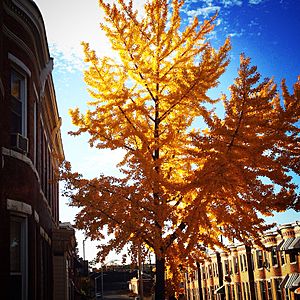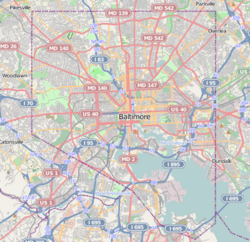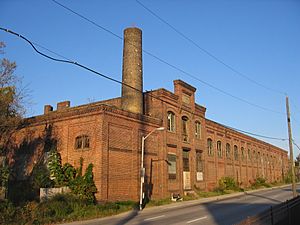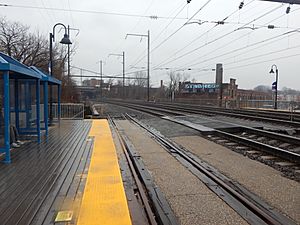Midtown-Edmondson, Baltimore facts for kids
Quick facts for kids
Midtown-Edmondson
|
|
|---|---|
|
Neighborhood of Baltimore
|
|

Mosher St. Swell-Front Rowhouses
|
|
| Country | United States |
| State | Maryland |
| City | Baltimore |
| Time zone | UTC-5 (Eastern) |
| • Summer (DST) | UTC-4 (EDT) |
| ZIP code |
21217
|
| ZIP code |
21223
|
Midtown-Edmondson is a busy neighborhood in western Baltimore City. It has a mix of homes, businesses, and industrial buildings. Most of the neighborhood was built between the 1880s and the 1910s. You'll find many residential rowhouses here. There's also a business area along Edmondson Avenue. Industrial buildings and warehouses are located near the CSX railroad tracks on the western side.
Contents
Where is Midtown-Edmondson Located?
Baltimore City says the neighborhood is bordered by North Bentalou Street to the west and North Monroe Street to the east. The northern borders are the CSX train tracks and West Lafayette Avenue. West Mulberry Street forms the southern border. Many people who live here also include a few blocks east of North Monroe Street, towards North Fulton Street. The neighborhood uses ZIP codes 21217 and 21223.
A Look at Midtown-Edmondson's Past
How the Neighborhood Grew
Building homes in Midtown-Edmondson started around 1887. Local builders created unique rowhouses and cottages. At first, these homes were like summer getaways for city residents. But when streetcars started running along Edmondson Avenue in the 1890s, more rowhouses were built. These new homes were for the city's growing middle class.
The area has both homes and factories. This shows how development was uneven after Baltimore County joined the city in 1888. People in Midtown-Edmondson worked hard to get money for important things like roads and water pipes. They also tried to stop factories and businesses from moving into their living areas. For example, they protested against the Ward Baking Company in 1925. They also opposed the Acme building and Interstate 170 (Maryland) highway construction in the 1970s.
After World War II, the people living in Midtown-Edmondson changed. In the mid-1940s, most residents were European American. By the early 1950s, the area became mostly African American. This change gave many middle-class African American families their first chance to buy a home. It also led to the creation of neighborhood groups. These groups played a big part in local civil rights efforts.
Even though all the buildings were finished by World War II, big changes happened after 1945. African Americans started moving west of Fulton Avenue in the mid-1940s. By the early 1950s, the neighborhood, which used to be separated by race, became mostly African American. From the 1960s until today, the neighborhood has faced challenges. These include empty houses and less money being invested in business areas like Edmondson Avenue. But the residents have kept working together to solve these community problems.
Early Development (1880s-1940s)
Factories and businesses in Midtown-Edmondson were built near the railroad tracks. They were also located along the old streetcar routes. Major streets like Lafayette Avenue and Edmondson Avenue offered more chances for businesses to grow. When the streetcar line expanded on Edmondson Avenue, many rowhouses became shops in the early 1900s. Old maps from 1914 show stores like a wallpaper shop, a paint store, a bakery, and a Chinese laundry.
A resident from this time, Jerry Leiber, remembered growing up above his family's candy store. He said the neighborhood had many Jewish-owned grocery stores. By 1951, all the rowhouses facing Edmondson Avenue between North Payson and Bentalou Streets had become businesses. Other businesses and factories were built from scratch.
American Ice Company
The American Ice Company building was built in 1911. It reminds us of West Baltimore's industrial past. It's located at 2100 West Franklin Street. The building has a power plant that backs up to the CSX Railroad tracks. This ice company was built when West Baltimore was growing fast. Small builders were putting up new rowhouses that stretched west towards Gwynns Falls.
The company was part of a new trend: "manufactured ice." Before this, ice was brought from rivers and lakes in the Northeast. But new factories could make ice more regularly. This changed the ice business. In 2004, a fire badly damaged the building. It hasn't been used since. The current owner wants to fix up the property. He plans to keep the historic ice house structure.
Ward Baking Company
The Ward Baking Company was built in 1925. Local residents strongly protested against a new factory in their neighborhood. The building is a nice brick structure. It was designed by C.B. Comstock, an architect from New York. The Ward Baking Company was based in Pittsburgh. It also had factories in other cities. The building is no longer a factory. It has been used as a church more recently.
Changes in the Mid-20th Century (1940s-1960s)
The racial makeup of Midtown-Edmondson changed differently than in nearby areas like Rosemont and Edmondson Village. The change happened slowly between the late 1940s and early 1950s. This was different from other areas where changes happened very quickly. This might be because these blocks were very close to Fulton Avenue. For almost 20 years, Fulton Avenue had been known as West Baltimore's "color line."
In the 1910s and 1920s, racial changes in West Baltimore sometimes led to violence. This happened against Black residents and white residents who rented or sold homes to Black people. By the start of World War II, the "color line" was mostly set around Fulton Avenue. But in the late 1940s, neighborhoods near this line started to change from white to Black. Many things caused this change. Baltimore's African American population grew quickly in the 1940s and 1950s. Also, historically segregated African American neighborhoods were very crowded. And white families moved out of the city center to new areas in the Baltimore suburbs.
Community Life and Challenges (1960s-2000s)
African American residents of Midtown-Edmondson created a new identity for the neighborhood. This happened in the 1940s, 1950s, and 1960s. New groups moved into the area. For example, the Bandolero's Motorcycle Club opened a clubhouse in 1967. The Uptown Bar was a popular spot for many West Baltimore residents.
After Martin Luther King Jr. was assassinated in April 1968, there were civil disturbances in Baltimore. These events affected many neighborhoods. Stores along Edmondson Avenue and Payson Street were looted. The Army worked to stop further looting. The disturbances ended after a few days. Across the city, there was a lot of damage.
Many small shops in the area closed in the 1970s and 1980s. But some older businesses, like Green's Hardware, stayed open. Later, the Super Pride Groceries store opened at Lafayette and Edmondson Avenue.
Black Panthers – 1971
In 1971, the Black Panthers started a free clothes program. It was on the 1800 block of Edmondson Avenue. This was part of a bigger "survival project" by the group. They also had a free medical clinic and a breakfast program for kids.
Super Pride Groceries – 1970s
Charles Thurgood Burns started Super Pride Groceries in 1970. He took over a struggling store. He rebuilt the business even though some food companies didn't want to work with a Black-owned store. Burns had worked in the grocery business since he was young. He later owned pharmacies that served Black customers when other businesses ignored them.
Between 1970 and 1990, Super Pride grew to seven locations. It hired over 400 people and made a lot of money each year. Under Burns's leadership, Super Pride supported Black History Month events. It also helped the Arena Players, a theater group. But by the late 1990s, the business struggled against bigger national stores. The city's population was also shrinking. In 2000, Super Pride closed all its stores.
Edmondson Community Organization – 1992
In the early 1990s, neighborhood residents worked to create the Edmondson Community Organization (ECO). In 1995, the U.S. government gave the ECO a building that used to be a nightclub. The ECO took over the building. But they had limited money, which made it hard to offer more services to the community.
The ECO Building still hosts meetings for Midtown-Edmondson residents and other groups. In the past, residents met there to form the West Baltimore Coalition. This group worked to develop the West Baltimore MARC Station area. The coalition also started a farmer's market that ran for several years.
ROOTS Fest – 2011
In 2011, several West Baltimore communities, including Midtown-Edmondson, held the ROOTS Fest. This five-day event aimed to bring West Baltimore communities together. It celebrated arts and culture. The festival took place over Interstate 170 (Maryland), which divides the community. It started with workshops about art, culture, and community action. The weekend had music, art, dancing, food, and other free activities. Thousands of people attended, including famous artists like Chuck Brown and Rising Appalachia.
Who Lives Here? (Demographics)
In 2010, there were 1,163 people living in Midtown-Edmondson. Most residents (97.6%) were African American. A small number were White (1.1%), Native American (0.1%), or Asian (0.1%). About 1.3% were from other races, and 0.8% were from two or more races. Hispanic or Latino people made up 0.4% of the population.
About 38.8% of the homes were owned by the people living in them. A large number, 51.1%, of homes were empty. About 48.1% of the people had jobs. The average household income was $23,819. About 32.2% of families and 30.8% of the population lived below the poverty line.
Historic Recognition
In 2014, parts of Midtown-Edmondson were included in the Edmondson Avenue Historic District. By 2015, the neighborhood was nominated to become its own historic district. This means its important buildings and history are recognized.
Getting Around (Public Transit)
Bus Routes
Midtown-Edmondson has three city bus routes:
- 15 travels from Security Square/Westview to Overlea/White Marsh.
- 23 goes from Rolling Road/Wildwood to Fox Ridge.
- 40 is a QuickBus from Security Square Boulevard at CMS to Middle River.
Train Service
The neighborhood also has the West Baltimore (MARC station). This station offers regional train service to Washington, DC. It's on the Penn Line of the MARC train service. Trains run seven days a week. The station also has 660 free parking spaces. Many of these were finished in late 2014.
Who Represents the Community?
Neighborhood Groups
The oldest group for citizens in Midtown-Edmondson is the Midtown-Edmondson Avenue Improvement Association (MEAIA). It is located at 2114 Edmondson Avenue, in the Edmondson Community Organization (ECO) building. The MEAIA meets on the last Thursday of each month at the ECO building.
City Council District
Midtown-Edmondson is part of Baltimore City's 9th City Council District. The current representative for this district is Councilman William "Pete" Welch.
State-Level Representation
Midtown-Edmondson is in Maryland House of Delegates District 44a. The current representative is Delegate Roxane L. Prettyman.
Federal-Level Representation
Midtown-Edmondson is located in Maryland's 7th Congressional District. U.S. Representative Kweisi Mfume currently represents this district.




